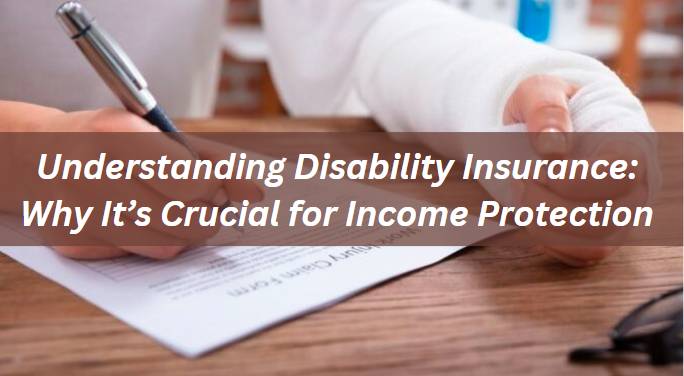Understanding Disability Insurance: Why It’s Crucial for Income Protection
Disability insurance is often overlooked in personal financial planning, but it plays a vital role in ensuring financial stability in the event of an unexpected disability. Whether due to illness or injury, being unable to work can significantly impact your income and overall financial health. This article explores the importance of disability insurance, its key features, and how to choose the right policy to protect your income.
Contents [hide]
Why Disability Insurance is Crucial
Income Replacement
The primary function of disability insurance is to replace a portion of your income if you become unable to work due to a disability. Unlike health insurance, which covers medical expenses, disability insurance focuses on replacing lost wages. This is essential for maintaining your standard of living and meeting financial obligations, such as:
- Monthly Bills: Ensuring you can cover rent or mortgage payments, utilities, and other living expenses.
- Debt Payments: Continuing to pay off loans, credit cards, and other debts.
- Daily Living Costs: Covering everyday expenses like groceries, transportation, and childcare.
Financial Security
A disability can have a substantial impact on your financial security, especially if you are the primary breadwinner or if your family relies on your income. Disability insurance provides a safety net, allowing you to focus on recovery without the added stress of financial hardship.
Protection Against Unexpected Events
Disabilities can arise from various causes, including accidents, chronic illnesses, or sudden health conditions. Disability insurance offers protection against these unexpected events, ensuring that you have financial support in case you are unable to work for an extended period.
Peace of Mind
Knowing that you have a safety net in place can provide peace of mind. Disability insurance allows you to concentrate on your recovery without worrying about how you will pay your bills or support your family.
Types of Disability Insurance
Short-Term Disability Insurance
Short-term disability insurance provides coverage for a limited period, typically ranging from a few weeks to six months. It is designed to replace a portion of your income for short-term disabilities that prevent you from working.
Pros:
- Quick Access: Benefits are often available sooner than long-term disability insurance.
- Affordable: Generally less expensive compared to long-term disability insurance.
Cons:
- Limited Duration: Coverage lasts only for a short period, which may not be sufficient for long-term disabilities.
Long-Term Disability Insurance
Long-term disability insurance offers coverage for extended periods, from several months to the duration of your disability or retirement age. It is designed for more severe or chronic disabilities that prevent you from working for a longer time.
Pros:
- Extended Coverage: Provides income replacement for an extended period, often until retirement age.
- Comprehensive Protection: Covers long-term disabilities that can significantly impact your ability to work.
Cons:
- Higher Premiums: Generally more expensive than short-term disability insurance.
- Waiting Period: Often includes a waiting period before benefits begin, which may require short-term disability coverage in the interim.
Supplemental Disability Insurance
Supplemental disability insurance is additional coverage that can be purchased to enhance the benefits of employer-provided disability insurance. It can help bridge gaps in coverage and provide a higher level of income replacement.
Pros:
- Enhanced Coverage: Increases the amount of income replacement beyond what is provided by employer insurance.
- Customization: Allows you to tailor coverage to meet your specific needs.
Cons:
- Additional Cost: Adds to the cost of your overall insurance coverage.
Key Features to Consider
Benefit Amount
The benefit amount is the portion of your income that will be replaced by the insurance policy. Typically, disability insurance replaces 50% to 70% of your pre-disability income. When choosing a policy, ensure that the benefit amount is sufficient to cover your living expenses.
Waiting Period
The waiting period, or elimination period, is the time you must wait before benefits begin. Short-term disability insurance typically has a shorter waiting period, while long-term disability insurance may have a longer waiting period. Choose a waiting period that aligns with your financial situation and needs.
Benefit Period
The benefit period is the length of time you will receive benefits. Short-term policies cover a limited duration, while long-term policies may provide benefits until retirement age. Consider your risk of long-term disability and choose a policy with an appropriate benefit period.
Coverage for Specific Conditions
Review the policy to ensure it covers the specific conditions that may affect you. Some policies may have exclusions for certain types of disabilities or conditions, such as pre-existing conditions. Ensure that the policy covers a broad range of potential disabilities.
Renewability and Portability
Consider whether the policy is renewable and portable. Renewable policies allow you to continue coverage without undergoing a new medical review. Portable policies can be carried with you if you change jobs, ensuring continuous coverage.
Riders and Add-Ons
Riders are additional features or benefits that can be added to a standard policy. Common riders include:
- Cost-of-Living Adjustment (COLA): Increases benefits to keep up with inflation.
- Residual Disability Rider: Provides partial benefits if you can work part-time but not full-time.
- Own-Occupation Rider: Provides benefits if you are unable to perform the specific duties of your occupation, even if you can work in another capacity.
How to Choose the Right Policy
Assess Your Needs
Evaluate your income, expenses, and potential risks to determine how much disability insurance coverage you need. Consider factors such as:
- Income Replacement: How much of your income do you need to replace to cover essential expenses?
- Duration of Coverage: How long do you need coverage for, based on your financial situation and health risks?
- Existing Coverage: What disability insurance coverage do you already have through your employer or other sources?
Compare Policies
Compare disability insurance policies from different providers to find the best fit for your needs. Consider factors such as premiums, coverage limits, waiting periods, and benefit periods.
Read the Fine Print
Carefully review the policy details, including exclusions, limitations, and definitions of disability. Ensure you understand the terms and conditions before purchasing.
Consult with an Insurance Professional
An insurance professional can help you navigate the complexities of disability insurance and find a policy that meets your specific needs. They can provide valuable insights and recommendations based on your individual circumstances.
Conclusion
Disability insurance is a crucial component of financial planning, providing essential income protection in the event of an unexpected disability. By understanding the importance of disability insurance and carefully selecting the right policy, you can ensure financial stability and peace of mind for yourself and your family. Assess your needs, compare policies, and consult with an insurance professional to find the best coverage for your situation.






















































Post Comment